Irvine Villages GUIDE
The story of Irvine Villages
From Woodbridge to Woodbury, Irvine’s 22 villages have distinct geographical features and personalities contributing to Irvine’s renowned quality of life. In this guide to Irvine’s villages learn how the village concept was envisioned seven decades ago by Irvine Company planners and hear what today’s residents have to say about the villages they call home.
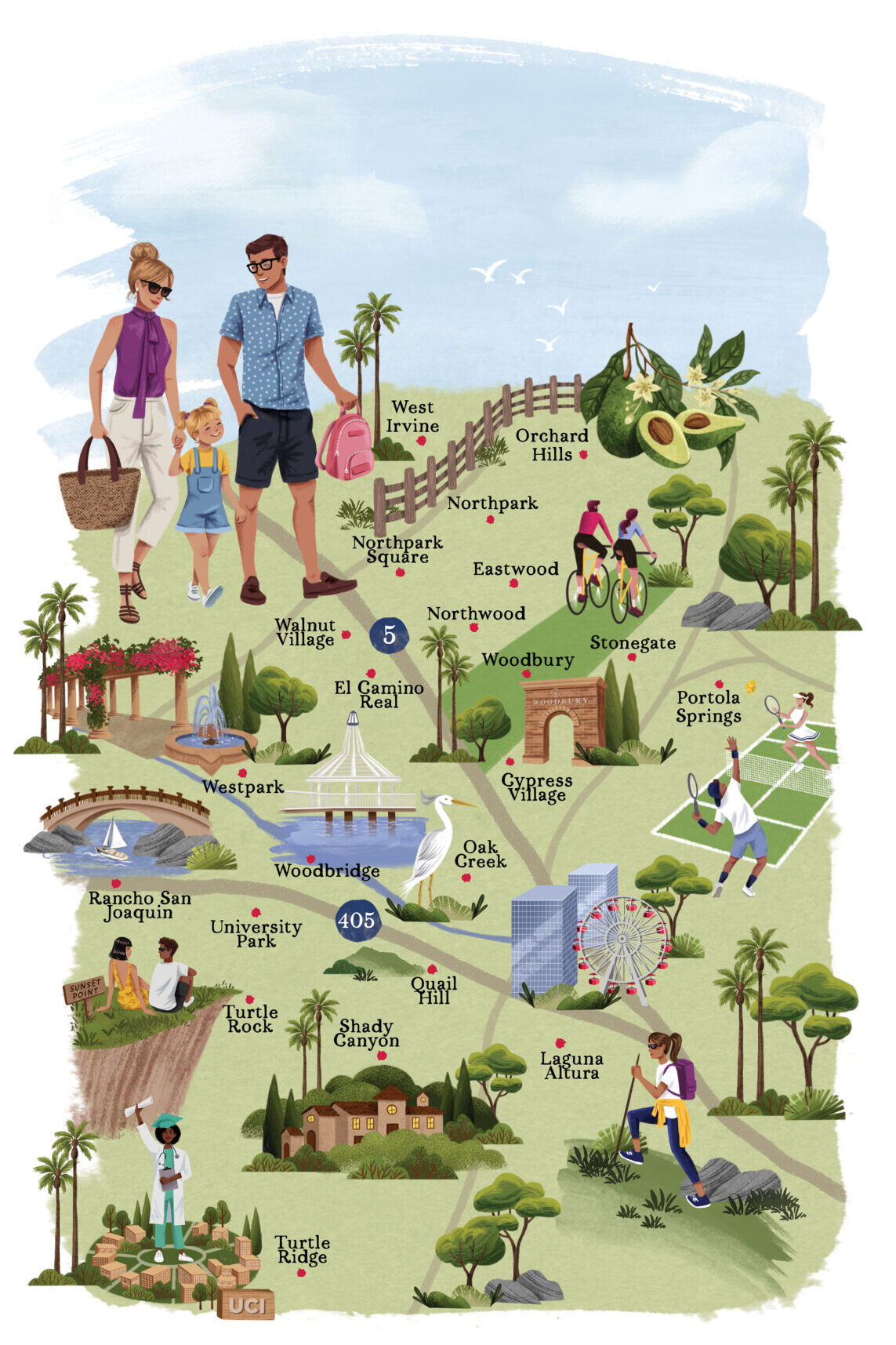
EST. 1966
First village in the city of Irvine
Irvine was planned as a “city of intellect” with villages emanating from the new UC Irvine campus. And as envisioned, one year after UC Irvine opened in 1965, University Park debuted. It is a picturesque community of greenbelts leading to local schools, parks and retail centers that establish a strong sense of community. Many original residents still call the village home. Alex Wong, who moved here in 1998 so his children could attend Vista Verde school, still rides his bike to the office, near UCI. “It’s a delightful commute that charges you up for the day,” he says.
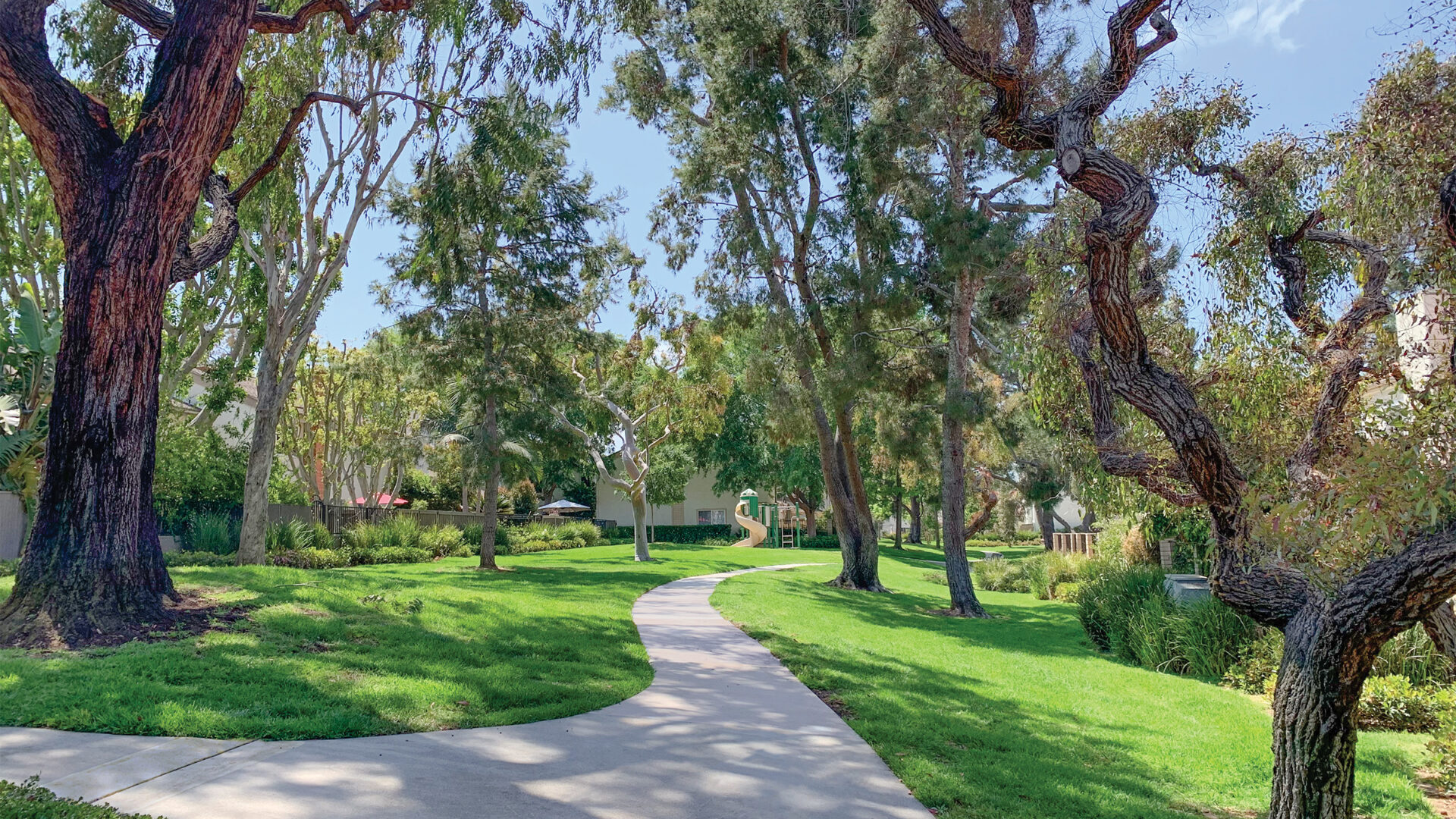
EST. 1970
Home to the popular Heritage Park
El Camino Real (“The King’s Highway”) is named for the trail that once connected California’s 21 Spanish missions and still runs through Irvine. It evokes a country village with its gardens, mature green spaces and many parks, including Heritage Park with a duck pond and expansive grounds. In 1984, it hosted Summer Olympics’ swimming events at the William Woollett Jr. Aquatics Center. It is also home to the Irvine Fine Arts Center, which has been inspiring local artists for more than 30 years.
EST. 1967
Irvine’s first hillside community
Turtle Rock is one of the original five villages that formed the city of Irvine and is its first hillside community. Today, it remains one of the city’s most admired places. Organized by a central looping road, homes are situated in thoughtful arrangements that leave the hilltops preserved, creating a careful balance between local nature and the built environment. “I can walk out my front door to Bommer Canyon and right down to Crystal Cove,” says resident Lori Stewart. “Every day, there’s a new adventure to explore.”
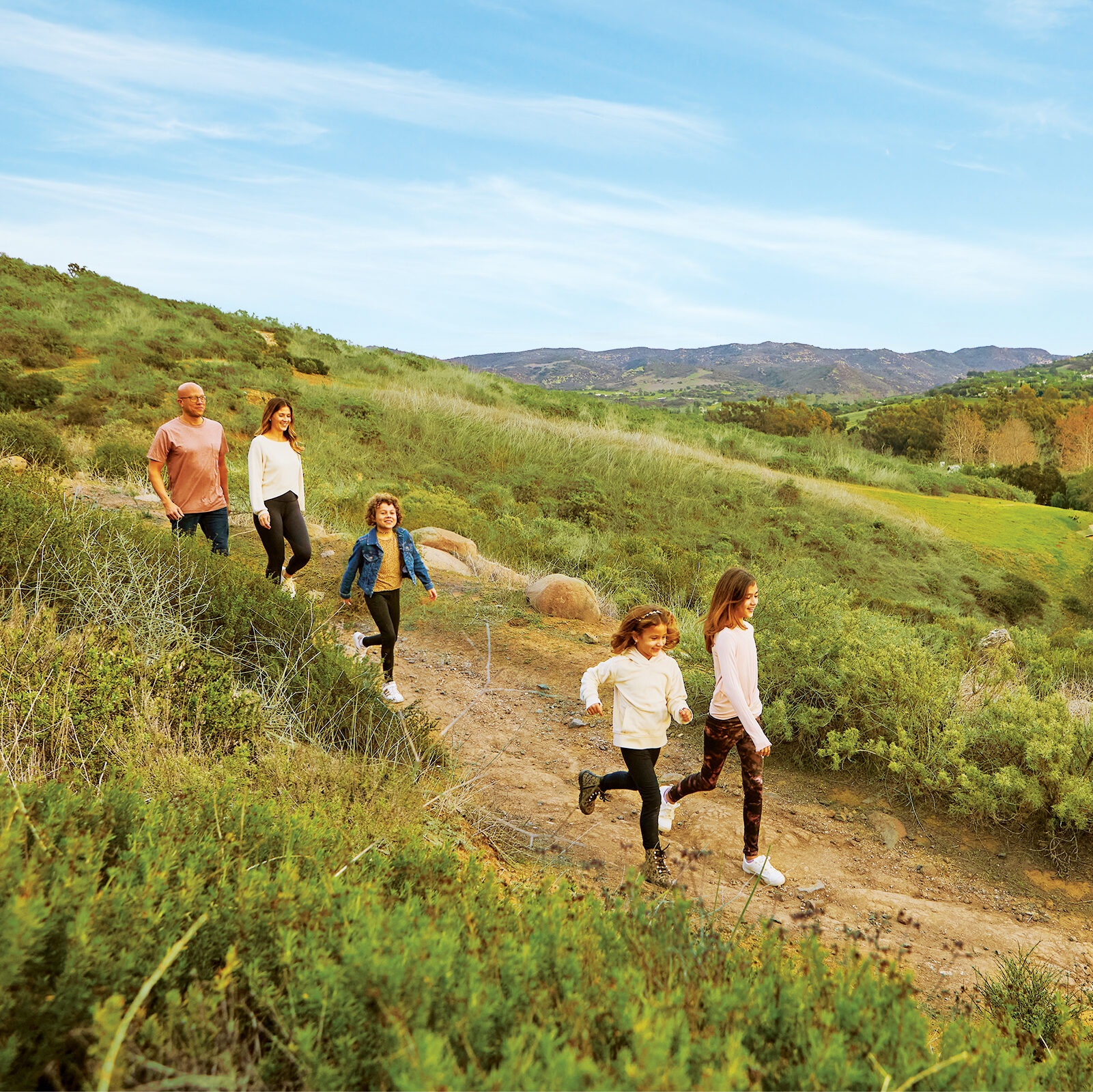
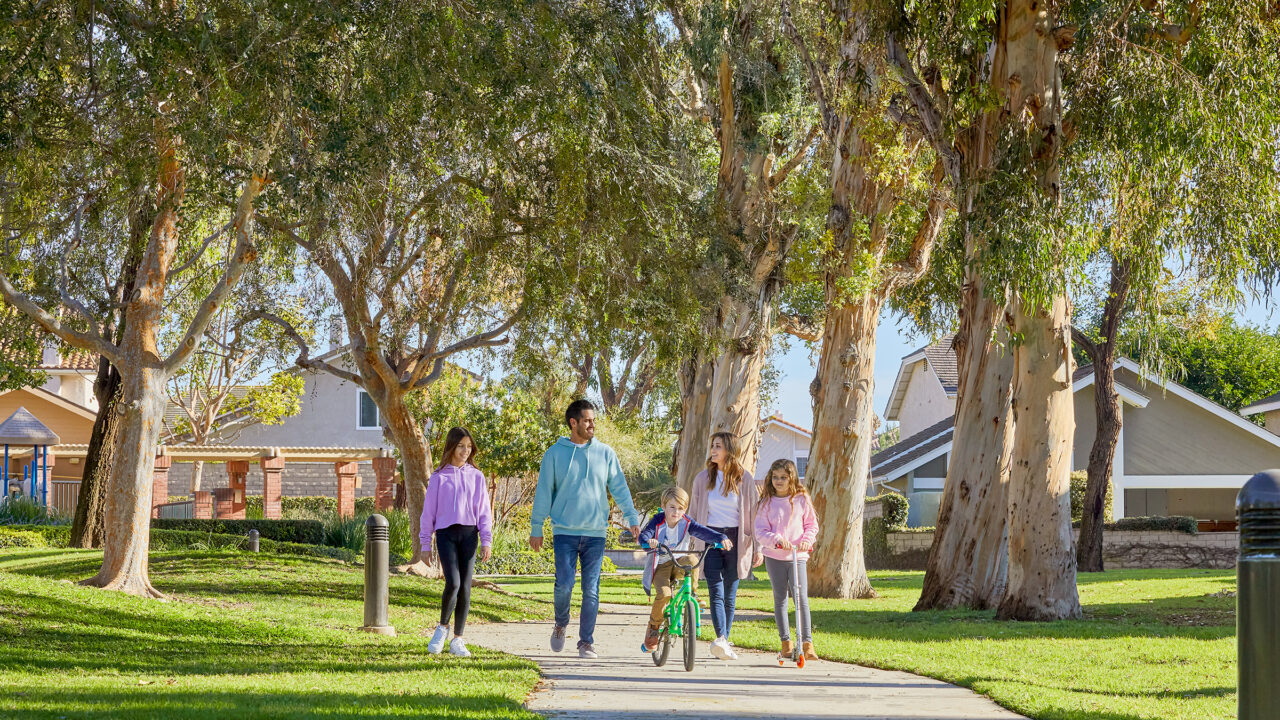
EST. 1970
Century-old trees define the landscape
More than any other village, Northwood is recognized for its eucalyptus windrows – many over a century old – that frame neighborhoods and line main thoroughfares. The village was built around the woodsy Hicks Canyon Trail and garden-like Venta Spur Trail, which allow Pastor Stephen Kimbrell and his wife to take an “incredibly relaxing” stroll through nature to grab a coffee at Northwood Town Center on his days off. “We’re definitely blessed to live here,” he says.
EST. 1975
Irvine’s best-known village
Located in the heart of Irvine, Woodbridge is formed by four quadrants and organized into smaller neighborhoods, each with its own park as its focus. Built in the 1970s and 1980s, it remains Irvine’s most recognizable village, with two central lakes and a lakeside shopping center, where architect Robert Puertas stops for coffee each morning with his dog Enzo. “The lakes encourage you to be outdoors,” he says. “And seeing your neighbors makes it even better.”
EST. 1972
Offering life on the golf course
Rancho San Joaquin is Irvine’s only village designed for active adults with grown or no children. It has no single-family homes, schools or playground. Instead, the village serves as a playground for adults, with an 18-hole golf course, tennis academy and the immense Mason Regional Park. These make Rancho an “upbeat, positive community with unbelievable walking and architecture,” says business owner Richard Denzer, who considers the location tops in the city.
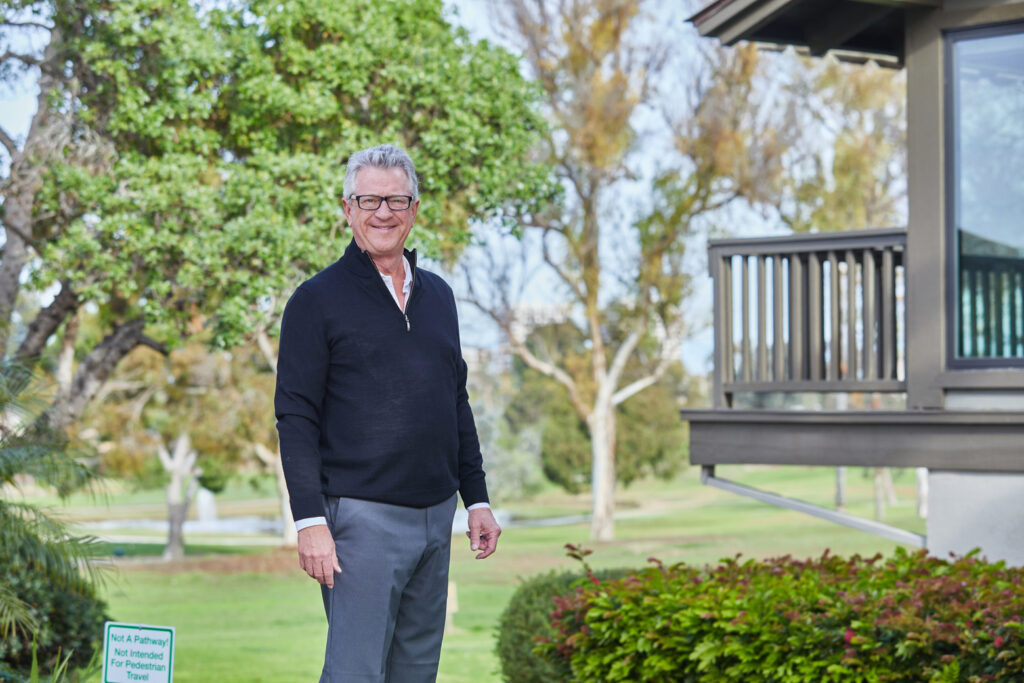
“This is an upbeat, positive community with unbelievable walking and architecture.”
EST. 1987
Home to the popular Bill Barber Park
Westpark was Irvine’s first Mediterranean-style village, introducing the city to coral-colored homes, terra cotta tiles – and palm trees. An “urban activity corridor” runs through the village, conveniently linking to neighborhood shopping centers and Irvine City Hall. The corridor also leads to Col. Bill Barber Marine Corps Memorial Park, a 42-acre expanse. With parks, trails, schools and three supermarkets nearby, dad Jeff Liu says, “We get so much done without even stepping into the car.”
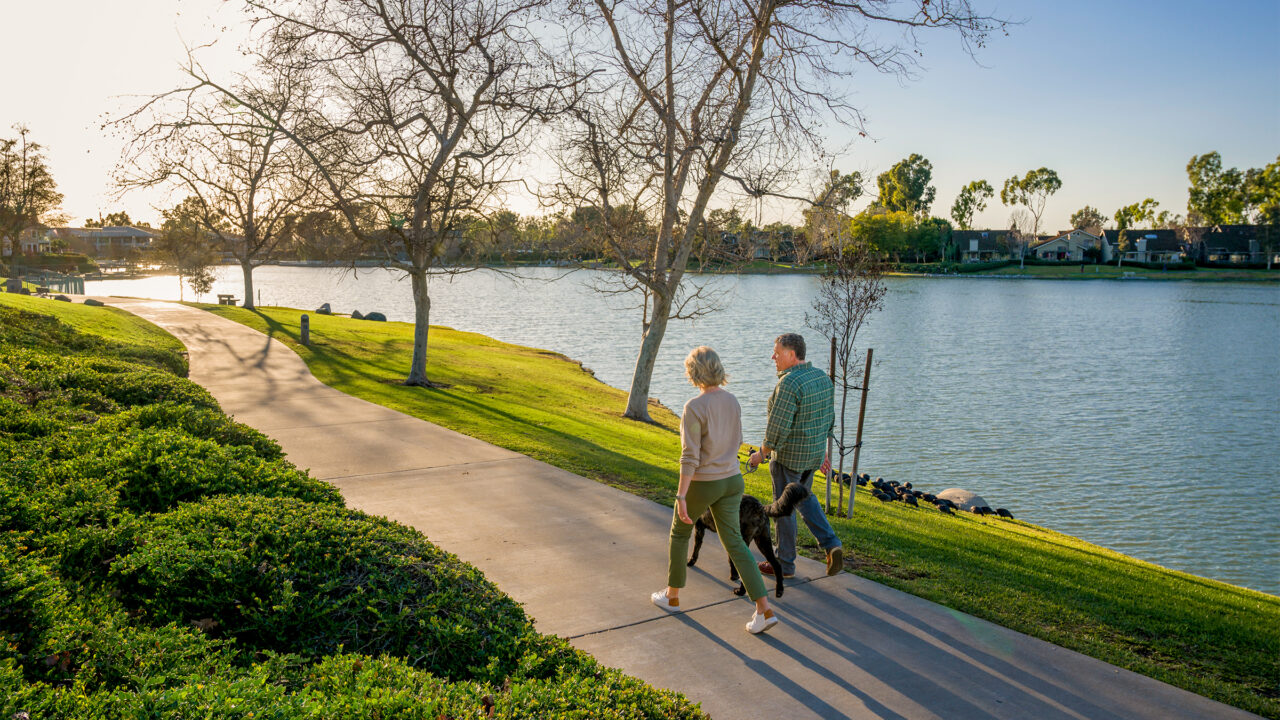
EST. 1997
Named for the groves that once defined the region
Walnut Village is deeply rooted in Irvine’s history. Named after the groves that established the region as “The Walnut Capital of the World,” the village was carefully landscaped with greenbelts and paths that “allow us to enjoy the wonderful weather to stay healthy, both mentally and physically,” says retired software analyst Jeff June. Walnut is just minutes from The Market Place, Irvine Spectrum, Fashion Island and the Southern California coast. Yet it retains its agricultural heritage with leafy parks, trails and open space, including the expansive Harvard Community Park.
EST. 1997
Connected to the 22-mile Mountains to Sea Trail
West Irvine holds one of the county’s most historic sites, one of its most popular shopping districts and its longest trail. The village center contains 24 original buildings, dating back to 1897, from the original Irvine Ranch. It is also home to The Market Place and its 140 stores and 40 restaurants. West Irvine borders the 22-mile Mountains to Sea Trail, where resident Jack Toan trains for triathlon events. “Access to amazing trails allows me to run and bike long distances in safety, away from traffic,” he says.
EST. 1998
A paradise of pools, trees and trails
The historic oak trees that line a portion of Sand Canyon Avenue are reminders of the timelessness of the village of Oak Creek. Features of the village include the Oak Creek Golf Club, which was carefully designed by Tom Fazio so that not a single home can be seen from the course. The village pool and village swim team are one of many destinations where neighbors get together. “Our kids grew up swimming for the Oak Creek Orcas, and every Saturday the whole community would get together to cheer for the children. We feel grateful to be here,” Emily Chien says. Residents also enjoy access to the San Diego Creek Trail that journeys through the heart of Irvine to the San Joaquin Marsh Wildlife Sanctuary.
EST. 1999
Neighbors are connected by pathways and parks
When Northpark’s first model homes opened in July 1999, potential buyers crowded tour buses to view them and enter a lottery for the chance to buy one. Ever since, families have been drawn to this village’s unique design of uncapped cul-de-sacs – with no homes at the ends – that encourage community interaction through a network of pathways. “There’s nowhere we’d rather be,” say Jason and Carol Shum. “It’s so great for family life. We always say we’ll retire here with all our Northpark friends and tell them, ‘No one is allowed to follow their kids to college!’ ”

“There’s nowhere we’d rather be.
It’s so great for family life.”
EST. 2001
Design pays homage to Tuscany and Provence
Located in the heart of North Irvine, Northpark Square is a thoughtfully planned village that features a graceful backdrop of rolling foothills. The village pays homage to the architectural heritage of cities such as Pasadena and Santa Barbara and the admired European regions of Tuscany and Provence. Residents enjoy access to four of the city’s most popular trails, which drew Ted Hsieh and his wife here over 20 years ago. “The walkability has transformed our lives and exceeded all of our expectations,” he says.
EST. 2001
One of OC’s most prestigious communities
Shady Canyon is one of OC’s most secluded and prestigious communities. The village boasts some 400 mostly custom-designed homes perched at different heights along narrow and winding roads to preserve views of thousands of acres of open space and a private 300-acre golf course. Miles of trails, many lined by stone walls, attract residents like Mary Anne Mattar, who says she has no problem getting in her 10,000 steps each day. “The expansive views on the trails only add to our quality of life. They are also a great place to connect with neighbors we see regularly, and new faces as well.” Some of those faces might be professional athletes or best-selling authors who call “Shady” home.
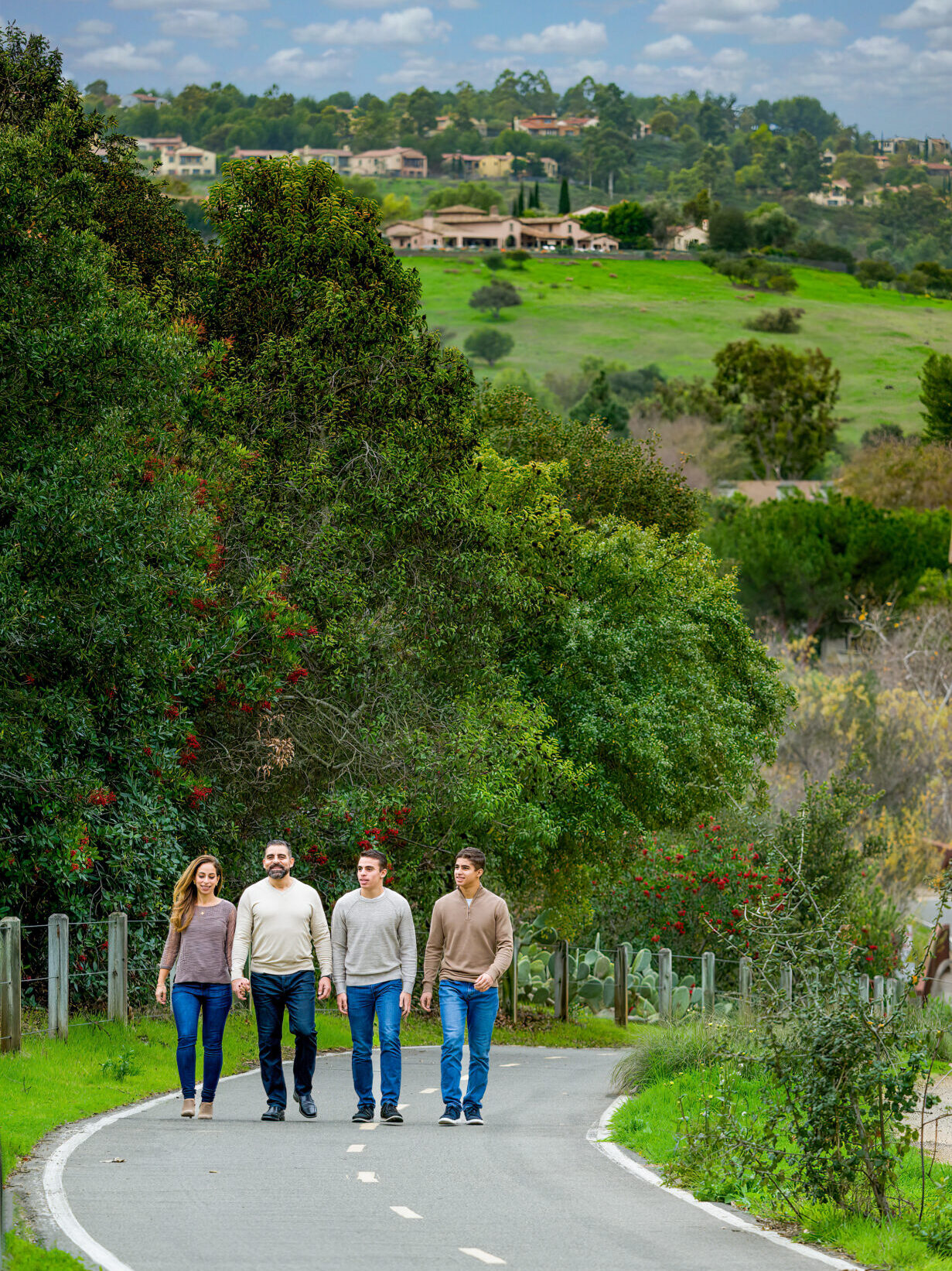
EST. 2003
Offers 360-degree ocean-to-mountain views
Turtle Ridge enjoys a unique, coastal microclimate that cools temperatures in the summer and warms them in winter. Perched atop the San Joaquin Hills, this rustic village overlooks Newport Coast and the entire Irvine basin. Architects drew upon nature’s contours to create a village connected to the land with winding nature trails. “With these views, we always feel like we are on a vacation,” resident Neil Estrada says. The village includes one of Irvine’s best-kept secrets: Sepulveda Vista Point, where you look out at Catalina Island on a clear day
EST. 2003
Fresh air and fine dining
Resident Amy Wang says it best: “Nestled in the foothills and surrounded by the Irvine Open Space Preserve, Quail Hill is a perfect balance between nature and city.” That perfect balance allows residents to walk to Irvine’s best-known landmark – the 700-acre Quail Hill Preserve – to be fully immersed in nature and then, on the walk back home, stop off at the adjacent retail center for lunch at one of 12 restaurants and bakeries. The village also features one of Irvine’s 22 community parks with a community center, patios and ballfields
EST. 2004
Named ‘Best Master-Planned Community’
Woodbury is defined by The Commons, a 30-acre amenity of parks, pools and playgrounds in the center of town. Residents enjoy exceptional walkability with each home just a few minutes’ stroll to the park and adjacent Woodbury Town Center. “We feel like we live at a resort,” says Chris Bonno. In 2005, the National Association of Home Builders named Woodbury the Best Master-Planned Community in America, praising its design to bring neighbors together “in such a visually pleasing way.”
EST. 2011
Gateway to Spectrum and the beach
Laguna Altura’s unique location gives residents access to two internationally renowned cities: Irvine, where the village is located near I-405 and SR-133, and the coastal Laguna Beach, just a short drive down fabled Laguna Canyon Road. In addition, the village gives residents easy access to thousands of jobs, as well as the many dining, shopping and entertainment options in Irvine Spectrum District. “We love being minutes to the Spectrum, the Great Park and Laguna Beach,” Kelly Tran says. “And all the amenities here make it easy to be outside.”
EST. 2006
Borders a 20,000-acre open space preserve
Portola Springs is defined by the character of the land. It is framed by a buffer of native habitat and agricultural lands on all sides, with the Loma Ridge open space providing a strong presence. The village’s five enclaves – each with its own identity – are designed around a new sports park and community center connected by a pedestrian bridge to a series of footpaths and trails. “There is always a hidden gem waiting to be explored,” Ana Tran says. A high-tech elementary school also provides a hub for the community. Portola Springs is one of only three villages with new homes for sale – ranging from townhomes to larger homes with ocean views.
EST. 2011
School is at the heart and geological center of the village
Stonegate Elementary School is the geographical center of this village. Landscaped pathways are populated each morning with neighbors who catch up while walking their children to school. “It’s special because we share the school with our neighbors, who become part of our extended family,” Shabira Jaffer says. This connection has helped make Stonegate a California Distinguished School. Other draws for this village include nine parks, eight pools and a recreation center.
EST. 2013
Runs along the Jeffrey Open Space Trail
Cypress Village delivers a resort-style vibe aimed at families who value getting outdoors – whether by the palm-tree lined, junior Olympic pools or the Jeffrey Open Space Trail. “The parks and trails are wonderful to connect with nature and enjoy time outdoors throughout the year,” says Jenny Reyes, adding they’re also a way to connect with friends and neighbors. “Everyone looks out for each other, creating an overall sense of belonging, which gives this village a true feeling of being at home.”
EST. 2014
Perched at Irvine’s highest point with ocean views
Sitting atop the city, Orchard Hills was designed around and within 900 acres of working avocado orchards that sweep down from the Lomas de Santiago Hills and connect to Irvine’s vast Northern Open Space Preserve. If you look west, you’ll spot Catalina Island, so Junko and David Cheng time their walks during the golden hour “for the dramatic sunset,” she says. The retail center features hundreds of mature olive trees with dining favorites like Zov’s, whose dishes embrace the village’s Mediterranean spirit. “We can’t believe we live in such a resort-like area,” Junko says.
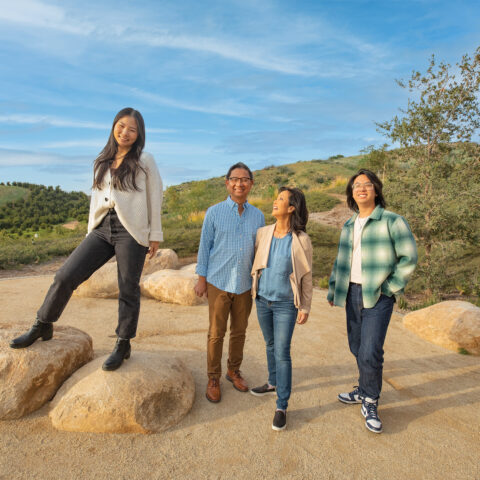
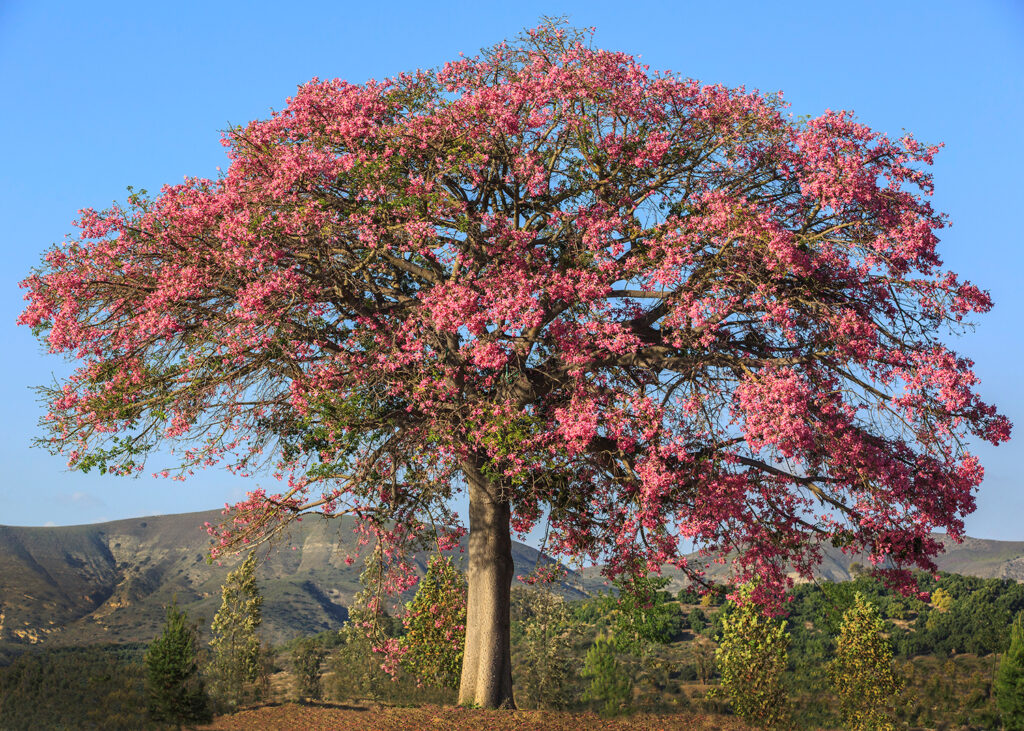
EST. 2016
Home to more than 15,000 trees
One feature that distinguishes Eastwood is lush landscaping. Over 15,000 trees were planted in the village, while old eucalyptus windrows line its entrance road. One tree in particular stands out: an 80-foot floss silk, preserved from The Irvine Ranch, that anchors a series of parks, playgrounds and paths connecting the entire village. “We absolutely love the beauty and convenience here,” says Mette Waldron. “We’re one block from school and three blocks from the pool, which allows us to spend family time together without getting in the car.”
A TALE OF TWO VILLAGES
Orchard Hills
‘It feels like we’re living in Tuscany’
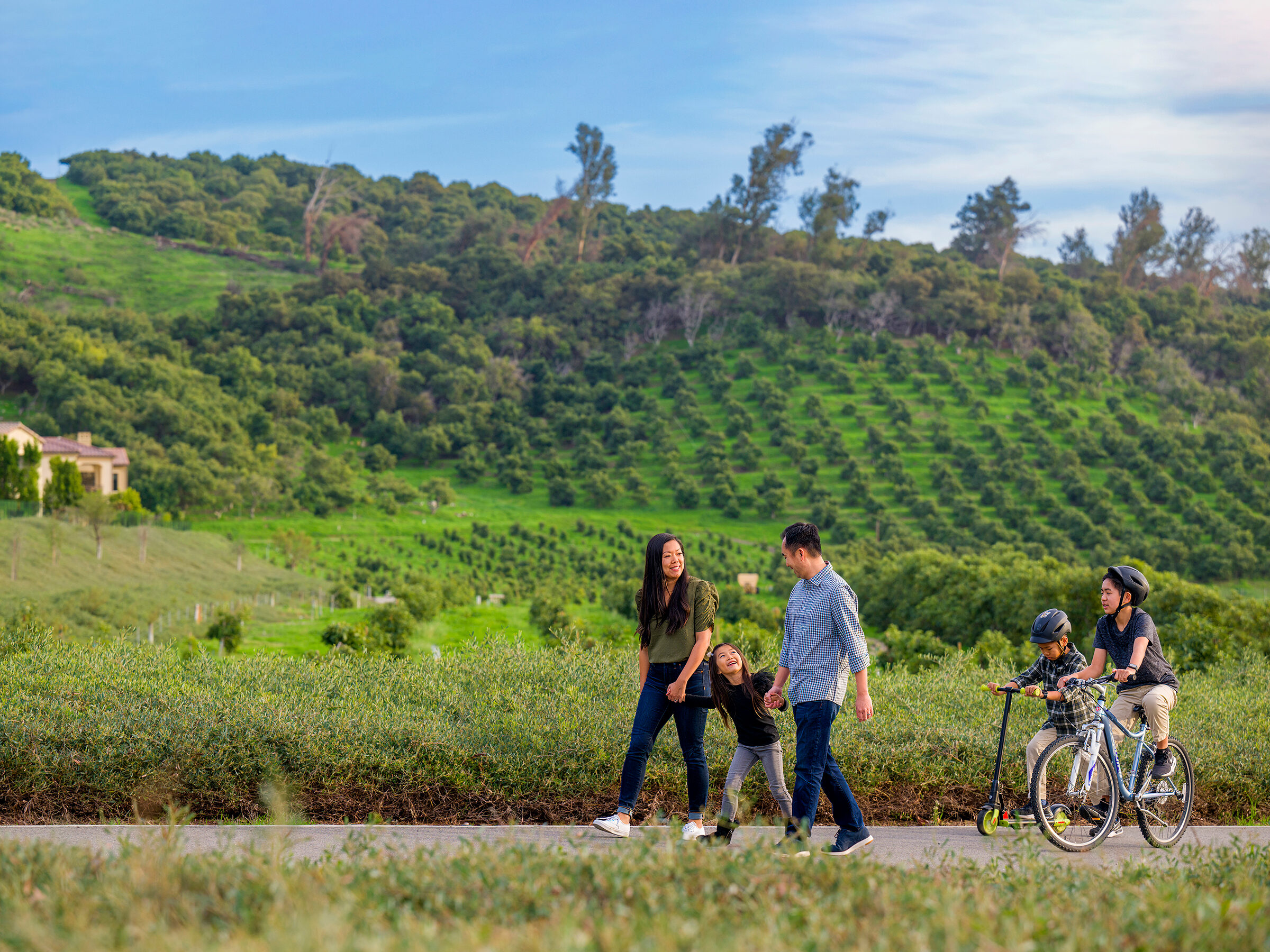
Jeannie Do grew up in Northwood Village, met her husband at UC Irvine, and now they’re raising three children in Orchard Hills, which she describes as “a perfect place to raise a family.” We asked what it’s like to live among the avocado orchards at the top of the city.
How did you choose Orchard Hills? I’ve lived in Irvine since kindergarten. When Orchard Hills was being built, we wanted to live here because everything is so walkable – the school, the shopping, the parks. It’s so beautiful. It feels like we’re living in Tuscany or something.
What’s it like raising a family here? Orchard Hills School is K-8, which allows all three kids to attend the same school and gives them a great education. It is a beautiful campus, walking distance from home, and we’re active in our school community. My kids’ after-school activities occur on campus, too – robotics, basketball and speech and debate.
Robotics? Yes. The school won the world championship last year, so they’re very focused on that program. They learn coding and building robots and the design process, too. Many families pay for their kids to go to private robotics classes, but we don’t have to.
What’s a typical week like for you? It’s rare that we leave the village. We use Orchard Hills Shopping Center for groceries, restaurants, coffee, going to the dentist. It’s local, so it feels more personal. We also walk to the park – Orchard Hills or Settlers. They have basketball courts for my older kids and a playground for my youngest to enjoy.
What’s your hope for the future? We hope the kids will live nearby when they grow up. I think they realize the value of living in Irvine. The Master Plan keeps everything updated and taken care of, and we feel fortunate to live in such a beautiful community.
Woodbridge
‘The best example of urban planning’
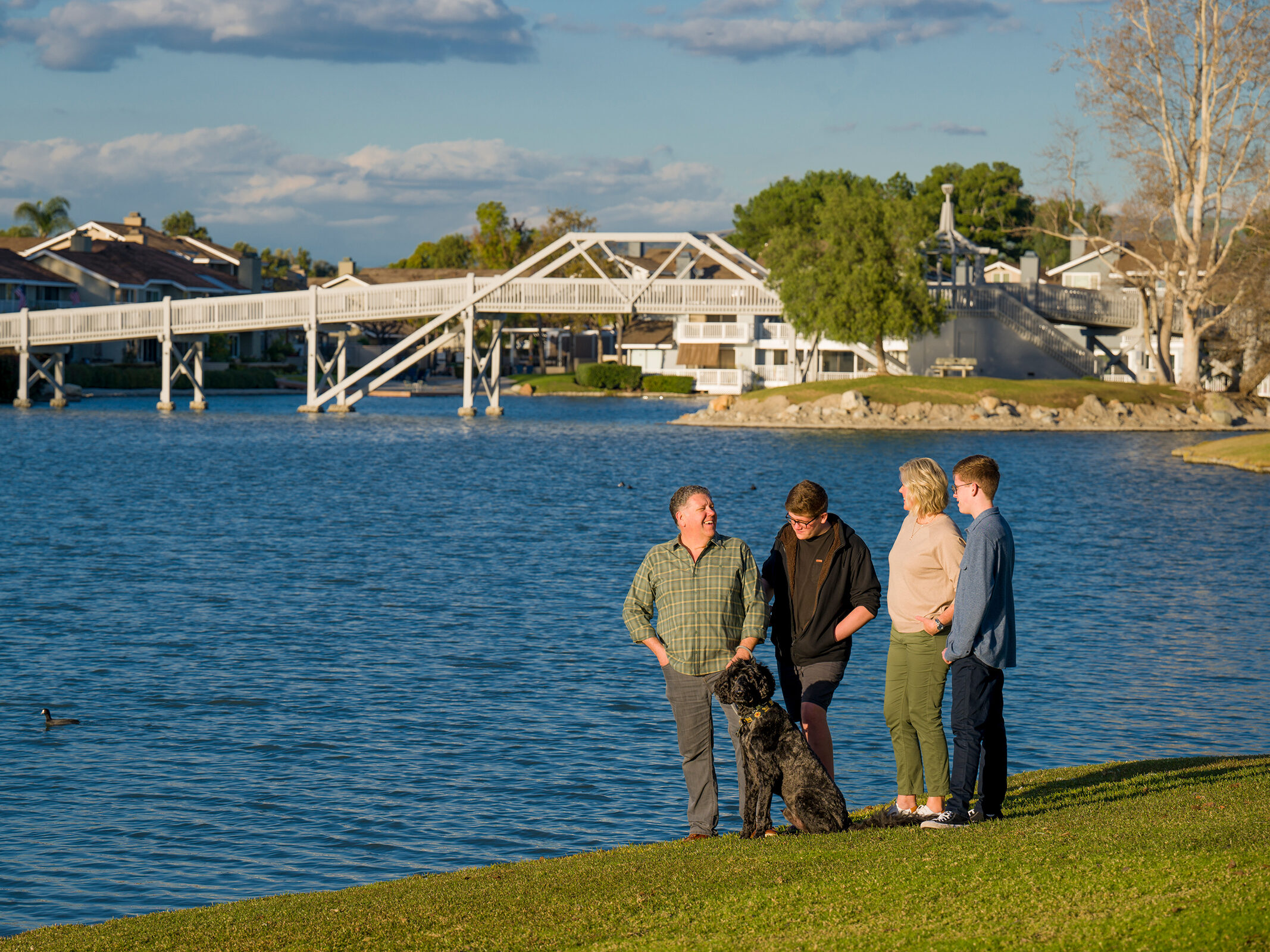
While architect Robert Puertas was earning his master’s degree at UC Berkeley, a professor held up examples of the best and worst urban planning. The best was Irvine and, after living in Woodbridge for 18 years, Puertas knows why. We asked him to explain.
What’s it like living in Woodbridge? The lake makes Woodbridge unique, especially the mountain views as you look north from Woodbridge Village Center, across the water. It’s an uplifting experience, and seeing friends and neighbors as we walk makes it even better.
As an architect, what do you notice about Woodbridge’s design? I grew up in Huntington Beach, and it’s a stark contrast: You drive along the streets and everything is a sidewalk with a tall block wall. No grass, no nothing. Then you pull into Woodbridge, and you’ve got this huge grassy area with all these trees. It’s just a different feel. It’s like, ‘OK, this is how you’re supposed to live.’ The design is an attraction for me.
How so? It’s both attractive and functional, which is exactly what successful architecture and urban planning do. They make you want to experience it, and they make it easy to experience.
Can you give us an example? Yes, the way that the paths work in Woodbridge is a perfect example. Our youngest son, who’s 14, doesn’t drive. And we love the fact that he can leave the house and go hang out with his friends and grab a bite at Woodbridge Village Center or see a movie – all of that without crossing a big street. The lake paths encourage us all to get outdoors and connect with friends and neighbors.